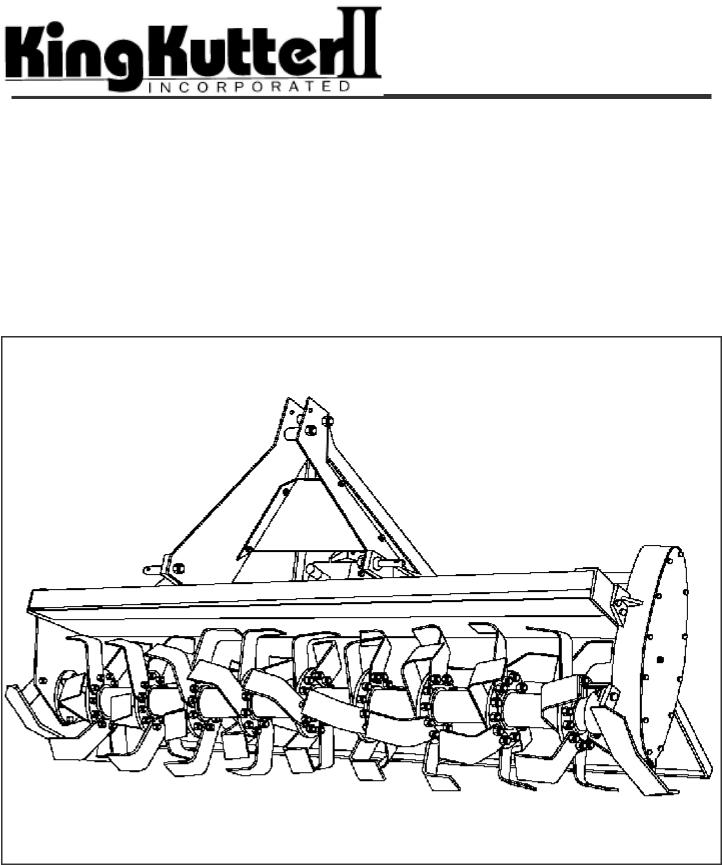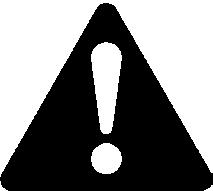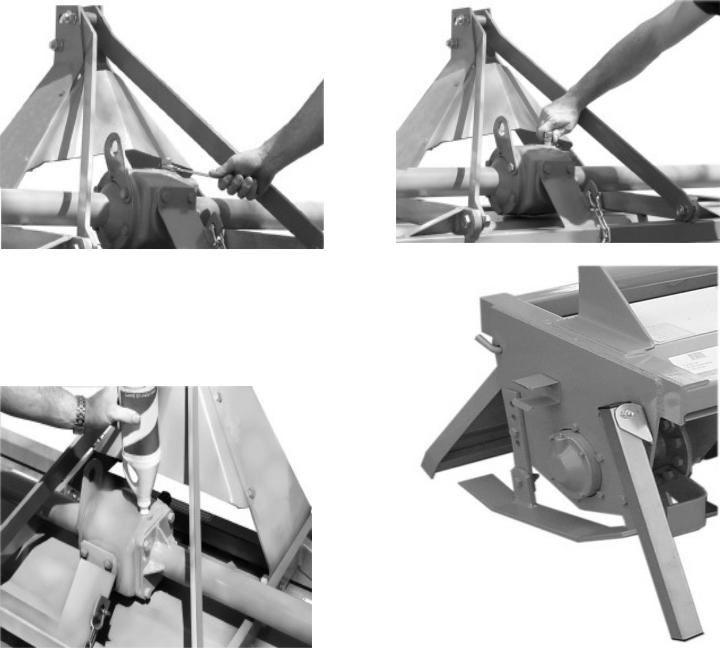King Kutter ROTARY TILLER User Manual

2150
Eastern Avenue. Gallipolis, Ohio 45631
ROTARY TILLER OPERATOR MANUAL
Part No 999995 |
www.kingkutter.com |
|
TO THE PURCHASER
This manual contains valuable information about your new King Kutter II Rotary Tiller. It has been carefully prepared to give you helpful suggestions for operating, adjusting, servicing and ordering repair parts.
Keep this manual in a convenient place for quick and easy reference. Study it carefully. You have purchased a dependable and sturdy tiller, but only by proper care and operation can you expect to receive the service and long life designed and built into it.
Sometime in the future your tiller may need new parts to replace those that are worn or broken. If so, go to your dealer and provide him with the model and part number.
Customer Information
Name ______________________________________________
Purchased From ______________________________________
Date Purchased ______________________________________
Model No. ___________________________________________
Serial No. ___________________________________________
3
It is the purchaser and/or operator’s responsibility to….
Read and understand the information contained in this manual.
Operate, lubricate, assemble and maintain the equipment in accordance with all instructions and safety procedures in this manual.
Inspect the equipment and replace or repair any parts that are damaged or worn which under continued operation would cause damage, wear to other parts, or cause a safety hazard.
Return the equipment or parts to the authorized King Kutter dealer, from where it was purchased, for service or replacement of defective parts that are covered by warranty. (The King Kutter Factory may inspect equipment or parts before warranty claims are honored.)
Payment of all costs incurred by the dealer for traveling to or transporting the equipment for warranty inspection and or claims.
4
CONTENTS |
|
ITEM |
PAGE |
Safety......................................................................... |
6 |
Assembly Instructions ................................................ |
8 |
Before Putting Into Service ........................................ |
8 |
Safety Training ......................................................... |
11 |
Transportation Safety............................................... |
15 |
Attaching To Tractor ................................................. |
16 |
Sizing PTO............................................................... |
18 |
Operating Instructions .............................................. |
19 |
Maintenance ............................................................ |
20 |
Maintenance Safety ................................................. |
20 |
Safety Decal's And Locations................................... |
22 |
Replacement Parts .................................................. |
28 |
PTO Shaft Parts ....................................................... |
30 |
Gearbox Parts.................................................... |
…..32 |
Warranty ………………………………………………...36 |
|
5

SAFETY
READ AND FOLLOW THE INSTRUCTIONS IN THIS MANUAL AND ESPECIALLY IN THE SAFETY SECTION. FAILURE TO DO SO CAN RESULT IN SERIOUS INJURY OR DEATH.
TAKE NOTE! THIS SAFETY ALERT SYMBOL FOUND THROUGHOUT THIS MANUAL IS USED TO CALL YOUR ATTENTION TO INSTRUCTIONS INVOLVING YOUR PERSONAL SAFETY AND THE SAFETY OF OTHERS.
THIS SYMBOL MEANS
ATTENTION!
BECOME ALERT! YOUR SAFTEY IS INVOLVED
SIGNAL WORDS:
The signal words DANGER, WARNING and CAUTION are used with the safety messages in this manual and with each safety signs. They are defined as follows:
DANGER: Indicates an immediate hazardous situation that, if not avoided, could result in serious injury or death. This signal word is to be limited to the most extreme situations typically for machine components that, for functional purposes, cannot be guarded.
WARNING: Indicates a potentially hazardous situation that, if not avoided, could result in serious injury or death, and includes hazards that are exposed when guards are removed. It may also be used to alert against unsafe practices.
CAUTION: Indicates a potentially hazardous situation that, if not avoided, may result in minor or moderate injury. It may also be used to alert against unsafe practice.
If you have any questions not answered in this manual or require additional copies or the manual is damaged, please contact your dealer or King Kutter, Inc. P.O. Box 1200 Winfield, AL 35594 (205) 487-3202 or www.kingkutter.com
6

EQUIPMENT SAFETY GUIDELINES
Safety of the operator and bystanders is one of the main concerns in designing and developing a tiller. However, every year accidents occur which could have been avoided by a few seconds of thought and a more careful approach to handling equipment. You, the operator, can avoid many accidents by observing the following precautions and insist those working with you, or for you, follow them.
In order to provide a better view, certain photographs or illustrations in this manual may show an assembly with a safety shield removed. However, equipment should never be operated in this condition. Keep all shields in place. If shield removal becomes necessary for repairs, replace the shield prior to use.
Replace any safety sign that is not readable or missing. Location of such safety signs are indicated in this manual.
Never use alcoholic beverages or drugs that can hinder alertness or coordination while operating this equipment. Consult your doctor about operating this machine while taking prescription medications.
Under no circumstances should children under the age of 18 be allowed to work with this equipment. Do not allow persons to operate or assemble this unit until they have read this manual and have developed a thorough understanding of the safety precautions and how it works. Review the safety instructions with all users annually.
This equipment is dangerous to children and persons unfamiliar with its operation. The operator should be a responsible, properly trained and physically able person familiar with farm machinery and trained in this equipment’s operations. If the elderly are assisting with farm work, their physical limitations need to be recognized and accommodated.
Use a tractor equipped with a Roll Over Protective System and seat belts. (ROPS)
Never exceed the limits of a piece of machinery. If its ability to do a job, or to do so safely, is in question- DON’T TRY IT.
Do not modify the equipment in any way. Unauthorized modification could result in serious injury or death and may impair the function and life of the equipment.
In addition to the design and the confirmation of this implement, including safety signs and safety equipment, hazard control and accident prevention are dependent upon the awareness, concern, prudence, and proper training of personnel involved in the operation, transport, maintenance, and storage of the machine. Refer also to safety messages and operation instruction in each of the appropriate sections of the tractor and tiller manuals. Pay close attention to the safety signs affixed to the tractor and the tiller.
7
ROTARY TILLER ASSEMBLY INSTRUCTIONS
STEP 1 With rotary tiller still in crate, lay flat on a level surface. Cut banding straps on the two (2) up right crate posts.
STEP 2 Remove the top & upper side sections of the crate, leaving the rotary tiller resting on the bottom section. You may take the tiller off of crate but you must swing stand arm down and lock in position. (See Figure D) Snap stand out of clip, straight out, then swivel the stand down to locked position.
STEP 3 Remove tie wire holding the PTO shaft and set aside PTO.
STEP 4 Attach tiller according to your tractors manual and using the instructions on pages 16 and 17.
STEP 5 Install tail back plate chain.
STEP 6 Install PTO shaft as outlined in the Attaching to Tractor Section, pg 1619.
Note: The safety chains on the PTO shaft should be attached to the tractor and tiller to prevent the plastic safety shield from rotating.
BEFORE PUTTING ROTARY TILLER INTO SERVICE
(IMPORTANT- INSTRUCTIONS PRIOR TO START UP)
SHIPPED WITH OIL IN GEAR BOXES
SHIPPED WITHOUT GREASE IN GREASE FITTINGS. UNIT MUST BE SERVICED BEFORE USING.
•In Gearboxes use gear oil (type GL5-85W 140 or Triple Zero Grease; which can be poured, and has "EP" i.e. "Extreme Pressure" additives.)
•For all Grease Fittings use TYPE/grade II tube grease.
STEP 1 Place rotary tiller so that the deck is secure and level.
STEP 2 Remove 1/2‖ Pipe Plug (Located at top of transmission gearbox). See Figure A.
STEP 3 Fill gearbox using gear oil until gearbox is approximately 1/2 full. See Figure B.
STEP 4 Replace and tighten the 1/2‖ pipe plug and clean away any excess oil.
See Figure C.
STEP 5 Remove 1/2‖ Pipe Plug (Located at top of side gearbox, See Figure E on page 10) and the 1/8" check plug (Located in side of the side gearbox) if oil comes out of check plug hole, replace plug immediately and go to STEP 7. If oil doesn’t come out go to
STEP 6.
8

STEP 6 Fill side gearbox using gear oil until the oil begins to overflow from the check plug hole. See Figure F on next page.
STEP 7 Replace and tighten the 1/2‖ vent plug and the 1/8" check plug. Clean away any excess oil. See Figure G on next page.
STEP 8 Grease the grease fitting on the "out-board hub," the two (2) grease fittings on the PTO universal joints, the two (2) grease fittings on the PTO safety shield and the inner surface portion of the PTO shaft. See Figures H, I and J on next page.
CAUTION:
DO NOT over fill gearbox. This could cause damage to oil seals and can cause permanent damage to the gearbox. This issue will not be covered under warranty.
|
|
|
|
|
|
|
|
Figure A |
|
|
|
Figure C |
|
|
|
|
|
|
|
|
|
|
|
|
|
|
|
|
|
|
|
|
|
|
|
|
|
|
|
|
|
|
|
|
|
|
|
|
|
|
|
|
|
|
|
|
|
|
|
|
|
|
|
|
|
|
|
|
|
|
|
|
Figure B |
|
|
|
|
Figure D |
|
|
|
|
|
|
|
|
|
|
|
|
|
|
|
|
|
|
|
|
|
|
|
|
|
|
|
|
9

Figure E
Figure G
Figure I
Figure F
Figure H
Figure J
10

SAFETY TRAINING
Safety is a primary concern in the design and manufacturing of our product. Unfortunately, our efforts to provide safe equipment can be wiped out by a single careless act of an operator or bystander.
In addition to the design and configuration of equipment, hazard control and accident prevention are dependent upon the awareness, concern, prudence and proper training of personnel involved in the operation, transport, maintenance and storage of this equipment.
It has been said, ― The best safety device is an informed, careful operator.‖ We ask you to be that kind of operator. It is the operator’s responsibility to read and understand all safety and operating instructions in the manual and to follow them. Accidents can be avoided.
Working with unfamiliar equipment can lead to careless injuries. Read this manual, and the manual for your tractor, before assembly or operating, to acquaint yourself with the machines. If this machine is used by any person other than you, or is loaned or rented, it is the rotary tiller owner’s responsibility to make certain that the owner's manual be available to the operator prior to operating:
1- Reads and understands the operator’s manuals.
2- Is instructed in safe and proper use.
Know your controls and how to stop the tractor, engine, and tiller quickly in an emergency. Read this manual and the one provided with your tractor.
Train all new personnel and review instructions frequently with existing workers. Be certain only a properly trained and physically able person will operate the machinery. A person who has not read and understood all operating and safety instructions is not qualified to operate the machine. An untrained operator exposes himself and bystanders to possible serious injury or death. If the elderly are assisting with farm work, their physical limitations need to be recognized and accommodated.
11
